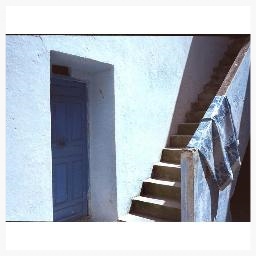Ourika Valley, Morocco
The Tzadik’s Last Berber-Jewish Protector
Hananiyah Elfassie is the last Berber Jew in the Ourika Valley of Morocco's High Atlas mountains, two hours by bus from Marrakech. Though most members of the Moroccan Berber tribes are Muslim today, some North African Berbers, like Elfassie's ancestors, were Jewish before Arab conquerors arrived here over 1300 years ago.
"Fifty years ago," Elfassie remembers, "Ourika had 300 Jewish families. We had two synagogues, Jewish schools, rabbis to perform circumcisions, bar-mitzvahs and weddings, and plenty of kosher food and matzah for Pesach." In those days, Elfassie worked the Ourika Valley's olive presses and traded Jewish crafts with local Berber Muslims.
Then Elfassie's Berber-Jewish family and friends joined a wave of Moroccan immigration to Israel in the 1950s and 1960s. Eventually, only Hananiyah Elfassie, his mother Saada, and his wife Yamna remained.
Saada Elfassie was born in Ourika and devoted her life to guarding the tomb of a tzadik, Rabbi Shlomo ben Hensh, dead 500 years but still revered like a saint. Like their Muslim counterparts, who revere each departed holy man, Jewish Berbers always made tzadik commemoration a cornerstone of their religious life.
When Saada died 24 years ago, Hananiyah and Yamna assumed sole responsibility for guarding the Tzadik's tomb, said to be the source of miracles. Yamna died two years ago. The couple never had children. Now, Hananiyah Elfassie is alone with three graves - those of his wife, his mother, and the man they stayed in Ourika to watch: the Tzadik.
Though the Elfassies have long been supported by tzedakah donations from pilgrims who come for blessings and miracles from the long-departed rabbi, few visit Hananiyah and his tzadik these days. Israeli tourism to Morocco halted with the renewed Palestinian Intifada and American and Western European tourism have slowed to a trickle since the September 11 terrorist attacks. But the spirit of the Tzadik has survived many crises during his five centuries interred in the Ourika Valley.
Although Hananiyah often considered making aliyah, his path was impeded by a recurring dream, which his wife likewise experienced. In their dream, a snake appeared and became a staff that blocked their home's doorway. Hananiyah believes this vision was a sign from the Rabbi, who fears his grave will be lost without Hananiyah's vigilance.
Hananiyah Elfassie clings to the hope that Rabbi Shlomo ben Hensh's spell is strong enough to attract new protectors to take his place preserving the Tzadik's memory -- the last vestige of Berber-Jewish history in Morocco's Ourika Valley. It may take a miracle.
A tablecloth dries on Friday afternoon in a sunny corner of the Hananiyah Elfassie's courtyard. He lives in a two-story facility, built with donations from foreign philanthropists in the 1970's and maintained by tzedakah from visitors and support from Morocco's king. Though not luxurious by Western standards, the home is much grander than the mud huts of many of Hananiyah's neighbors.
Yamna Elfassie stood in the doorway to the tomb of Rabbi Shlomo ben Hensh. Yamna was the last Berber Jewish woman in the Ourika Valley of Morocco's High Atlas Mountains, two hours by bus from Marrakech. After over 40 years of marriage, she died in 2000, leaving her husband Hananiyah as the only remaining Jew in the Ourika Valley.
Hananiyah Elfassie, the last Jew in the Ourika Valley of Morocco's High Atlas mountains, guards the tomb of a "Tzadik" who died 500 years ago. Foreign pilgrims visiting the Tzadik's tomb taped snapshots of famous rabbis to the wall behind him.
Once there were 300 Jewish families, two synagogues, Jewish schools, rabbis to perform circumcisions, bar-mitzvahs and weddings, and no shortage of kosher meat and matzah in the Ourika Valley. Then, in the 1950's and 1960's, all of the Ourika Valley's Berber Jews made aliyah to Israel, leaving only Yamna and Hananiyah el-Fasil. Today, none of the people are Jews in the red mud huts that make up the nine small, hillside villages lining the river.
Yamna and Hananiyah Elfassies told the story of why they stayed in the Ourika Valley. They remained in the Ourika Valley to protect the tomb of Rabbi Shlomo ben Hensh, decades after all the other Jews left. Rabbi ben Hensh died more than 500 years ago, but they revered him as a Tzadik who lived after death, stopped the sun's course, and even turned into a snake to ensure himself a proper Jewish burial. Because of a recurring dream they shared, in which a snake became a staff blocking their path, the Elfassies were afraid to leave the gravesite. The Tzadik's tomb is said to be the source of miracles.





